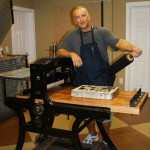Printmaking Techniques available at Blue Fig Editions
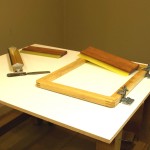 Silk Screen (Serigraphy) is created by one of the few printmaking processes in which pulling the print does not result in a reversed image. It is a stencil technique in which the stencil is adhered, or exposed to a screen of mesh fabric stretched tightly over a frame. Silk was originally used but polyester and nylons are generally used today. Ink is forced through the mesh with a flexible squeegee (rubber blade). the first color is applied to the entire edition quantity and then the second color thereafter and so forth for each additional color.
Silk Screen (Serigraphy) is created by one of the few printmaking processes in which pulling the print does not result in a reversed image. It is a stencil technique in which the stencil is adhered, or exposed to a screen of mesh fabric stretched tightly over a frame. Silk was originally used but polyester and nylons are generally used today. Ink is forced through the mesh with a flexible squeegee (rubber blade). the first color is applied to the entire edition quantity and then the second color thereafter and so forth for each additional color.
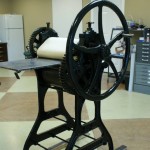 Etching / Intaglio is a technique in which a print is taken from a sheet of metal, usually copper, zinc or steel, into which the drawing has been bitten with acid. It involves coating a metal plate with a thin acid resistant layer or ground, usually a wax based resin. Using a sharp tool, a drawing is scratched into this layer leaving the metal exposed. The plate is then immersed in a bath of acid which ‘bites’ or etches away the metal in the areas exposed by the drawing. Once the lines have been etched to a sufficient depth the ground is cleaned off. Ink is rubbed into the lines of the design and the surface is wiped clean. A sheet of dampened paper is placed over the plate and it is then fed through a printing press under great pressure. This causes the ink to be pulled out of the incised lines onto the paper and creates the plate mark. Engraving and drypoint techniques can also be used in combination with this method of etching to achieve results.
Etching / Intaglio is a technique in which a print is taken from a sheet of metal, usually copper, zinc or steel, into which the drawing has been bitten with acid. It involves coating a metal plate with a thin acid resistant layer or ground, usually a wax based resin. Using a sharp tool, a drawing is scratched into this layer leaving the metal exposed. The plate is then immersed in a bath of acid which ‘bites’ or etches away the metal in the areas exposed by the drawing. Once the lines have been etched to a sufficient depth the ground is cleaned off. Ink is rubbed into the lines of the design and the surface is wiped clean. A sheet of dampened paper is placed over the plate and it is then fed through a printing press under great pressure. This causes the ink to be pulled out of the incised lines onto the paper and creates the plate mark. Engraving and drypoint techniques can also be used in combination with this method of etching to achieve results.
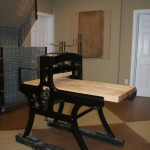 Lithograph literally means ‘stone drawing’. When lithography was invented in Germany in the late 18th century, the print was created by drawing on a special type of smooth limestone, although a metal/plastic surfaces are sometimes used today. It is a planographic or surface process which is based on the fact that grease and water repel each other. Using a greasy medium (a crayon) a drawing is made on the surface of the stone which is dampened with water. Greasy printing ink is then rolled over the surface. The ink adheres to the drawing but is repelled by the damp paper. Any medium, so long as it is oil based, can be used to draw the image and this explains why lithographs can have so many different appearances and are sometimes mistaken for original drawings.
Lithograph literally means ‘stone drawing’. When lithography was invented in Germany in the late 18th century, the print was created by drawing on a special type of smooth limestone, although a metal/plastic surfaces are sometimes used today. It is a planographic or surface process which is based on the fact that grease and water repel each other. Using a greasy medium (a crayon) a drawing is made on the surface of the stone which is dampened with water. Greasy printing ink is then rolled over the surface. The ink adheres to the drawing but is repelled by the damp paper. Any medium, so long as it is oil based, can be used to draw the image and this explains why lithographs can have so many different appearances and are sometimes mistaken for original drawings.
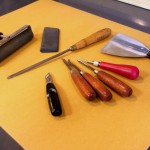 Relief Printing is a process in which the image to be printed is created in relief. Unwanted areas are cut away and the image area is left in relief so that when the ink charged roller is passed over the block only the areas in relief receive ink. Woodcut, wood engraving and linocut are examples of relief printing.
Relief Printing is a process in which the image to be printed is created in relief. Unwanted areas are cut away and the image area is left in relief so that when the ink charged roller is passed over the block only the areas in relief receive ink. Woodcut, wood engraving and linocut are examples of relief printing.
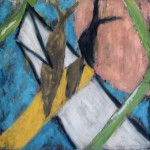 Monotypes is unique is that no two prints are alike; although images can be similar, editioning is not possible. The appeal of the monotype lies in the unique translucency that creates a quality of light very different from a painting on paper or a print, and the beauty of this media is also in its spontaneity and its combination of printmaking, painting and drawing mediums. The artist applies ink onto a clean plate or screen and literally paints onto it, once the image is complete it is run through the rest of the printing process.
Monotypes is unique is that no two prints are alike; although images can be similar, editioning is not possible. The appeal of the monotype lies in the unique translucency that creates a quality of light very different from a painting on paper or a print, and the beauty of this media is also in its spontaneity and its combination of printmaking, painting and drawing mediums. The artist applies ink onto a clean plate or screen and literally paints onto it, once the image is complete it is run through the rest of the printing process.
Collographs takes its name from the French colle, meaning glue, and the Greek graphos, meaning drawing. Essentially, it is a print from a collage. The plate is built up using a collage process which combines materials as diverse as cardboard, fabric, gesso, glue and found objects. Collographs do not necessarily have to be in color. They can be printed blind, where an un-inked plate is put through the printing press to produce an embossed effect on the sheet.
